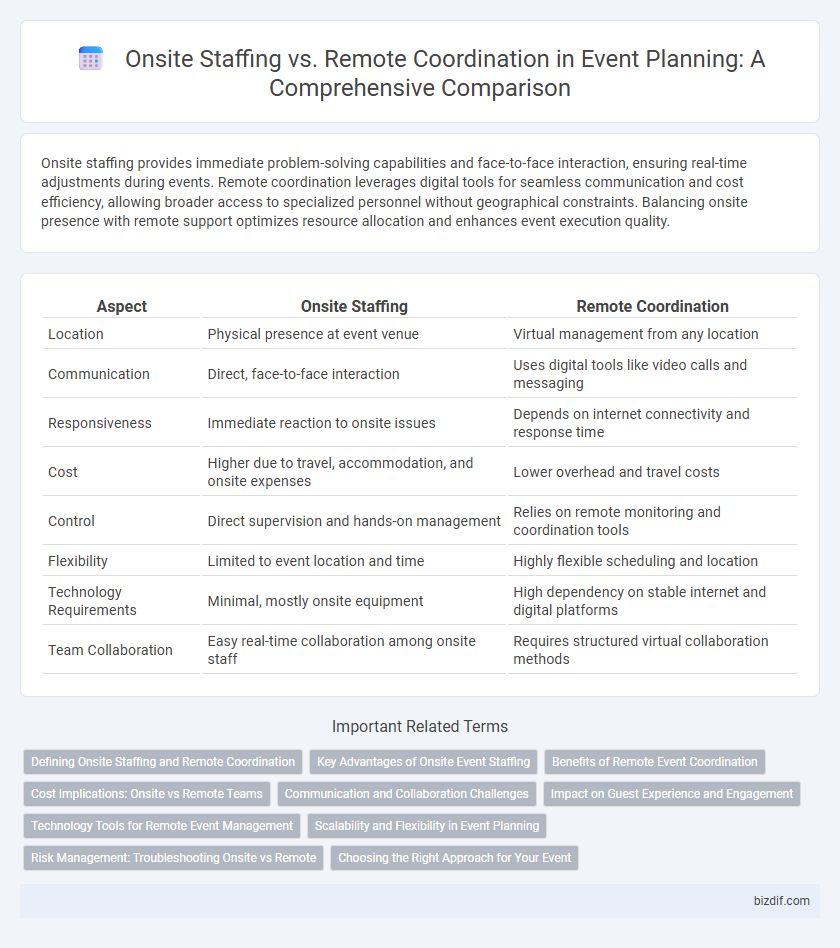Onsite staffing provides immediate problem-solving capabilities and face-to-face interaction, ensuring real-time adjustments during events. Remote coordination leverages digital tools for seamless communication and cost efficiency, allowing broader access to specialized personnel without geographical constraints. Balancing onsite presence with remote support optimizes resource allocation and enhances event execution quality.
Table of Comparison
| Aspect | Onsite Staffing | Remote Coordination |
|---|---|---|
| Location | Physical presence at event venue | Virtual management from any location |
| Communication | Direct, face-to-face interaction | Uses digital tools like video calls and messaging |
| Responsiveness | Immediate reaction to onsite issues | Depends on internet connectivity and response time |
| Cost | Higher due to travel, accommodation, and onsite expenses | Lower overhead and travel costs |
| Control | Direct supervision and hands-on management | Relies on remote monitoring and coordination tools |
| Flexibility | Limited to event location and time | Highly flexible scheduling and location |
| Technology Requirements | Minimal, mostly onsite equipment | High dependency on stable internet and digital platforms |
| Team Collaboration | Easy real-time collaboration among onsite staff | Requires structured virtual collaboration methods |
Defining Onsite Staffing and Remote Coordination
Onsite staffing involves deploying team members physically at the event location to manage logistics, guest interactions, and real-time problem-solving, ensuring smooth operations. Remote coordination utilizes digital tools and communication platforms to oversee event planning and execution from a distance, optimizing resource allocation and reducing costs. Both approaches require clear role definitions and efficient communication to achieve seamless event management.
Key Advantages of Onsite Event Staffing
Onsite event staffing ensures real-time problem solving and immediate response to attendee needs, enhancing overall event flow and guest satisfaction. Having trained professionals physically present facilitates seamless communication among team members and quicker adaptation to unexpected challenges. This direct engagement significantly reduces delays and miscommunication compared to remote coordination, improving event execution quality.
Benefits of Remote Event Coordination
Remote event coordination streamlines communication by leveraging cloud-based tools, enabling seamless real-time updates across geographically dispersed teams. This approach significantly reduces travel expenses and logistical complexities, enhancing overall cost-efficiency. Additionally, remote coordination allows access to a broader talent pool, ensuring specialized skills are available without location constraints.
Cost Implications: Onsite vs Remote Teams
Onsite staffing in event planning incurs higher costs due to travel, accommodation, and per diem expenses, while remote coordination reduces overhead by leveraging virtual communication tools and eliminating physical presence needs. Remote teams offer scalable solutions with lower fixed costs, yet onsite teams provide immediate problem-solving capabilities that can save money by preventing last-minute issues. Balancing cost implications requires assessing event complexity, with remote coordination favored for routine tasks and onsite staffing reserved for high-stakes, real-time event management.
Communication and Collaboration Challenges
Onsite staffing enables direct face-to-face communication, fostering immediate problem-solving and real-time collaboration that streamlines event execution. Remote coordination often faces delays due to reliance on digital communication tools, increasing the risk of misinterpretation and slower decision-making. Both methods require tailored strategies to overcome challenges in maintaining seamless teamwork and clear information flow across diverse environments.
Impact on Guest Experience and Engagement
Onsite staffing enhances guest experience by providing immediate assistance, personalized interactions, and seamless problem-solving, which fosters higher engagement and satisfaction. Remote coordination relies on technology to manage logistics efficiently but can create delays in response time and less personal connection, potentially diminishing guest involvement. Optimizing event success often requires balancing onsite presence with remote support to maintain high engagement levels and smooth operations.
Technology Tools for Remote Event Management
Technology tools for remote event management enhance communication and collaboration through platforms like Zoom, Microsoft Teams, and Slack, ensuring seamless coordination without physical presence. Cloud-based project management software such as Asana and Trello enables real-time task tracking and resource allocation, optimizing efficiency for distributed teams. Advanced analytics tools provide insights into attendee engagement and event performance, allowing remote coordinators to make data-driven decisions and improve overall event outcomes.
Scalability and Flexibility in Event Planning
Onsite staffing provides direct management and immediate problem-solving, enhancing control over event logistics and guest experience, while remote coordination offers greater scalability by leveraging virtual tools to manage multiple events simultaneously across various locations. Flexibility increases with remote coordination as it allows event planners to quickly adapt schedules and resources without physical constraints, whereas onsite teams may face limitations due to space and personnel availability. Balancing onsite presence with remote coordination maximizes both scalability and flexibility, optimizing event execution and resource allocation.
Risk Management: Troubleshooting Onsite vs Remote
Onsite staffing enables immediate risk management by allowing event planners to address technical issues and unforeseen challenges in real-time, minimizing disruptions. Remote coordination relies heavily on digital communication tools, which can delay troubleshooting and complicate urgent responses due to lack of physical presence. Effective event risk management often balances onsite expertise with remote support to ensure quick resolution and seamless event execution.
Choosing the Right Approach for Your Event
Choosing between onsite staffing and remote coordination depends on the event's scale, complexity, and real-time needs. Onsite staffing ensures immediate problem-solving and personalized guest interaction, critical for large-scale or high-profile events. Remote coordination offers cost efficiency and flexibility, making it ideal for smaller events or when leveraging technology platforms for communication and management.
Onsite staffing vs Remote coordination Infographic

 bizdif.com
bizdif.com